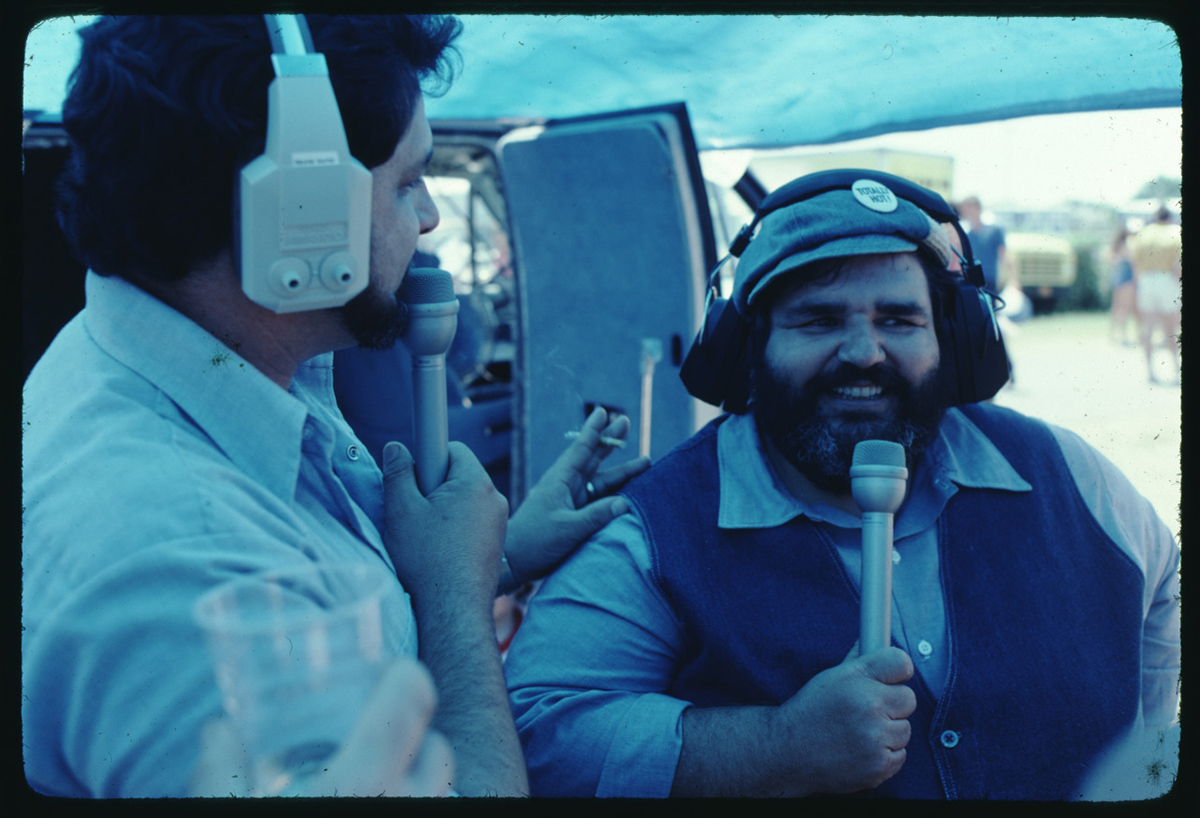Paul Prudhomme
An unofficial cultural ambassador for Louisiana beginning in the 1970s, Paul Prudhomme was a Cajun chef, restauranteur, author, television star, and entrepreneur.

The Historic New Orleans Collection
Chef Paul Prudhomme being interviewed at the New Orleans Jazz & Heritage Festival. 1982. Michael P. Smith, photographer.
Paul Prudhomme was a Cajun chef, restaurateur, author, television star, and entrepreneur who found success in New Orleans. One of the nation’s earliest and most notable culinary celebrities, he was an unofficial cultural ambassador for Louisiana beginning in the 1970s.
Born on July 13, 1940, and raised on his family’s sharecropper farm outside Opelousas, Prudhomme was the youngest of Eli Prudhomme Jr. and Hazel Reed’s thirteen children. At the age of seven, after his sisters had moved out, Prudhomme began helping his mother in the kitchen. Back then, his family called him Gene Autry, in homage to the famous “Singing Cowboy,” and was unaware that the name on his birth certificate was put there by his baptismal priest who insisted that he be christened for a saint.
In 1957, barely out of high school and newly married, Prudhomme opened a hamburger stand in Opelousas named Big Daddy O’s Patio. The restaurant didn’t last nine months, nor did his marriage. He moved to New Orleans, where he sold magazines. That job took him out west, mostly around Colorado, where he eventually bounced between kitchen postings. According to food journalist Brett Anderson, who produced a lengthy oral history of Prudhomme’s career in 2005, “The realization that the food [Prudhomme] learned to cook at his mother’s hip was foreign to people outside southern Louisiana prompted him in 1970 to move back to New Orleans.”
There, he took a sous-chef position at Le Pavillon hotel, and later Maison Dupuy, where he began cooking more Louisiana-tinged dishes. In 1975 Ella Brennan hired Prudhomme to be the first American-born executive chef at Commander’s Palace, which, in the tradition of high-end restaurants of the day, had previously hired only European chefs. He transformed the menu by introducing Cajun dishes like a roux-based chicken and andouille gumbo.
National reporters descended on the always packed Commander’s dining room. Prudhomme, now a star, appeared on the cover of Bon Appétit magazine and was profiled in the New York Times. Brennan nicknamed Prudhomme’s cuisine “nouvelle Creole.” But looking back at his five-year tenure at Commander’s, Prudhomme called it, “down-and-dirty Cajun.”
In 1979 Prudhomme and his second wife, Kay Hinrichs, opened K-Paul’s at 416 Chartres Street. Compared to the pricey Commander’s, lunch and dinner at the French Quarter restaurant cost just $5 to $6. There was no book of recipes, no freezers, and no wine list. Communal seating accommodated only sixty-four guests. No reservations or credit cards were accepted. “It was a real dump. The chairs was wobbly. The tables were uneven,” he said. “But I liked it.”
Prudhomme and his team cooked whatever they wanted, with the freshest ingredients. K-Paul’s was an immediate blockbuster of a success, with lines stretching for blocks down the sidewalk. A joke of the era said that “getting into K-Paul’s was harder than getting into East Germany,” which was closed off to the West at that time by the Berlin Wall.
With K-Paul’s, Prudhomme brought Cajun food—andouille, tasso, crawfish, jambalaya—to New Orleans and, with his countless media appearances, arguably the world. But the dish that became his most famous creation wasn’t Cajun in the least. That recipe, originated in March of 1980, involved fillets of redfish dipped in butter, dredged in cayenne and dried herbs, and seared in a hot-to-smoking cast-iron skillet. Blackened redfish, as Prudhomme called the dish, became so popular that it depleted the Gulf of Mexico’s redfish population. K-Paul’s eventually set a limit of one order per table.
Prudhomme rode the American regional cooking and early celebrity chef waves of the 1980s. His first cookbook, Chef Paul Prudhomme’s Louisiana Kitchen, was published in 1984. It’s instantly iconic cover photo portrays a plump-faced and beaming Prudhomme dressed in chef whites and toque surrounded by an array of foods: smoked meats, seafood, a pecan pie, sweet potatoes, and mirlitons. Ten more cookbooks would follow.
A K-Paul’s pop-up launched in New York in 1985. A permanent location followed four years later and was greeted with the New York Times headline: “Jambalaya Passion Feeds Lengthy Lines on Broadway.” It closed in 1993, the same year Prudhomme lost his wife to lung cancer. He renovated the original K-Paul’s soon after, tripling its size.
Prudhomme hosted two volumes of Louisiana Kitchen cooking tutorials, as well as numerous television food and travel shows first broadcast by New Orleans’s PBS affiliate WYES. He traveled the world as an American culinary celebrity and Louisiana cultural ambassador, often while promoting his line of dry spices, sauces, marinades, and smoked meats: Magic Seasoning Blends. Always a portly man, Prudhomme struck an unforgettable figure, with his distinctive country Cajun accent and chef whites. He signed books, ended interviews, and shook hands with his catchphrase, “Good cooking, good eating, good loving!”
Paul Prudhomme died in New Orleans on October 8, 2015, at the age of 75. He was survived by his third wife, Lori Bennett, whom he married in 2010. He mentored many chefs, most notably Emeril Lagasse and Frank Brigtsen, and inspired countless more. K-Paul’s closed for good, due to the COVID-19 pandemic, in the summer of 2020.
